
Types of Spoons
Regardless of what's on your menu, you probably utilize a spoon at some point in the preparation process. Whether used for stirring coffee, making spaghetti, or ladling soup, spoons are a kitchen and dining staple with a wide range of uses. Each type of spoon has a specific purpose, including measuring, stirring, eating particular foods, and cooking. As you restock your utensils or plan what you need for your brand-new restaurant, use this guide to learn more about the different types of spoons for cooking, serving, eating, measuring, and other special tasks.
Shop All Spoons
Use the following links to learn more about spoons:
Whether you work as a professional chef or baker, you likely have a large assortment of cooking spoons. As a kitchen staple, cooking spoons are essential for stirring, scooping, and plating various food items. Each of the different spoons used for cooking has distinguishing features and advantages, which determine which task the spoon should perform. Below are several common types of cooking spoons every kitchen should have.

Wooden Spoon
No commercial kitchen is complete without at least one wooden spoon. Due to wood's versatility, durability, and distinctive characteristics, these spoons are handy for any task. Not only are wooden spoons comfortable in your hand as you stir, but they are also non-conductive. As a result, you can keep preparing hot sauces without the spoon heating up and burning your hand. Additionally, wooden spoons are especially helpful when stirring in non-stick pans since they won’t scratch or damage the surface.
Uses: Stirring hot foods for long periods, cooking in a non-stick pan, stirring delicate ingredients, serving
Size: Varies depending on style of spoon

Slotted Spoon
Not only can you use a slotted spoon to stir and scoop food, but the slots in the spoon's base, also known as the bowl of the spoon, allow you to strain food with it. The long handle makes these spoons ideal for cooking in deep pots and bowls. Additionally, use slotted spoons to pick up boiled eggs, vegetables, potatoes, and other large items from hot cooking liquids.
Uses: Cooking pasta, basting, removing large food items from hot liquids
Size: 10 to 21 inches long

Bar Spoon
Essential to any bartending tool kit, a bar spoon has a long handle and a small, curled bowl that makes it perfect for stirring drinks. Many bar spoons also have a twisted stem that helps retrieve items from the bottom of a glass. While bar spoons can come from several different materials, many bartenders choose some sort of metal for its heavy weight and balanced feel to assist stirring.
Uses: Stirring mixed drinks, layering drinks, transporting garnishes, crushing ingredients, retrieving debris from the bottom of a drink
Size: 12 inches long, can hold 5 milliliters or 1 teaspoon of liquid
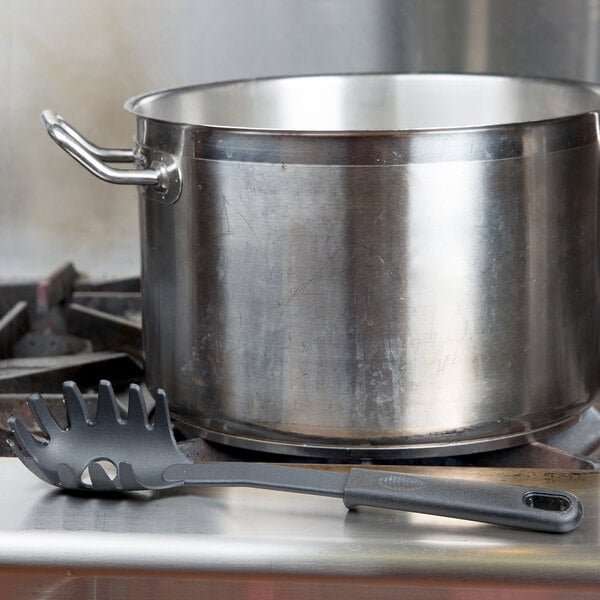
Spaghetti Spoon
While it might look like any other pronged cooking spoon at first, a spaghetti spoon stands out due to the large hole in the middle of the bowl. According to Barilla, an Italian pasta manufacturer, one serving size of spaghetti is a grouping approximately 2 1/8 inches in circumference. As a result, the hole in the bowl of a spaghetti spoon is precisely this size to help cooks measure one serving size with ease. Additionally, the pronged edges of the spoon make scooping and serving long pasta effortless.
Uses: Cooking and serving spaghetti and other long pasta
Size: 10 to 21 inches long, hole is 2 1/8 inches in circumference
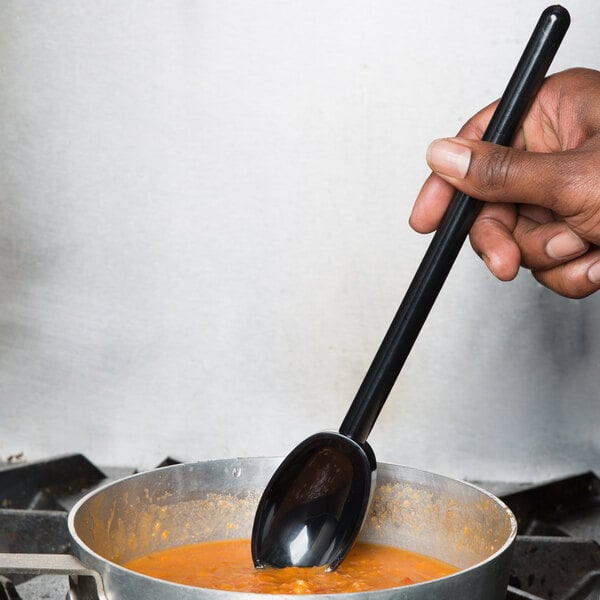
Mixing Spoon
Whether you’re making batter or salsa, a mixing spoon is an essential tool for your kitchen. While these utensils appear ordinary, mixing spoons are distinguished by their shallow bowl and thick, curving edges. These qualities make it easy to guide it through thick and thin mixtures for a better blend. However, the shallow bowl makes scooping and serving more challenging, so it’s best to use a different spoon for that task.
Uses: Mixing soups, hot entrees, batters, salsa, drinks, and liquid-based desserts
Size: Average 15 to 16 inches in length, can be as short as 10 inches and as long as 22 inches
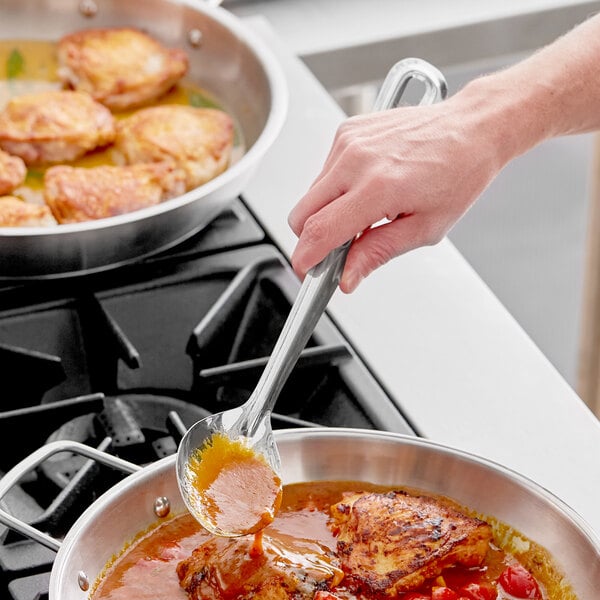
Basting Spoon
A basting spoon has a large bowl ideal for scooping cooking juices, marinades, and other liquids during the basting process. Made from stainless steel, silicone, or wood, the long handle of basting spoons allows you to reach the bottom of hot pots and pans without burning your hand. Due to the bowl's design, you can control how quickly you pour your marinade without any trouble.
Uses: Basting meat and fish during cooking
Size: 10 to 15 inches
From soup ladles to rice spoons, there are many types of serving spoons essential for your operation. Some serving spoons are best for self-serve buffets or catering, while others are only used in the kitchen. As you assess your restaurant's needs, check out some common types of serving spoons and their functions, materials, and sizes.

Ladle
Recognizable by its curved handle and deep bowl, a ladle is the best serving spoon for soups, sauces, and other liquid-heavy dishes. Ladles often have pouring lips on one side of the bowl, allowing cooks to scoop, pour, and strain liquid ingredients. Large ladles can also fish big food pieces out of a wide pot, making them excellent for draining vegetables or stew meat.
Uses: Serving soup, stew, and sauce
Size: 10 to 15 inches on average, can hold 4 to 8 ounces of liquid
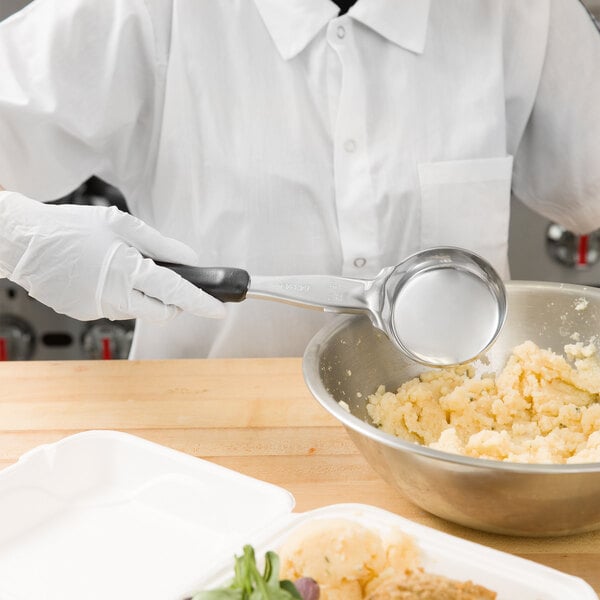
Spoodle
As the name implies, a Spoodle® is a cross between a regular serving spoon and a ladle, and it is proprietary to Vollrath. Typically used to cover pizza dough with sauce or serve vegetables, Spoodles® have wide bowls with a flat bottom used to spread the sauce. The long, straight handle often has an additional plastic grip for comfort. Some have perforated bowls, allowing you to strain food before serving.
Uses: Spreading sauce on pizza, serving vegetables or pasta
Size: 10 to 15 inches long, bowl size varies depending on your choice
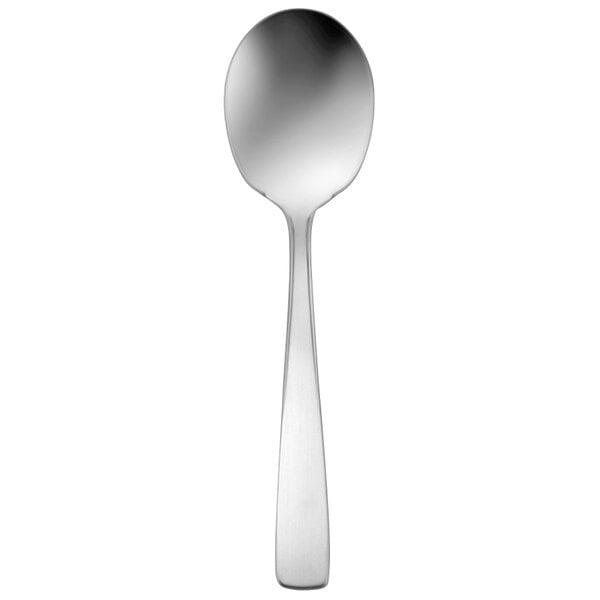
Sugar Spoon
Well-known in high-end restaurants, a sugar spoon serves granulated sugar with coffee or tea. With a volume of one teaspoon, the bowl often resembles a shell. Given the formal setting, sugar spoons are usually made from stainless steel and have intricate decorative designs.
Uses: Serving sugar in a formal dining setting
Size: Roughly the size of a teaspoon
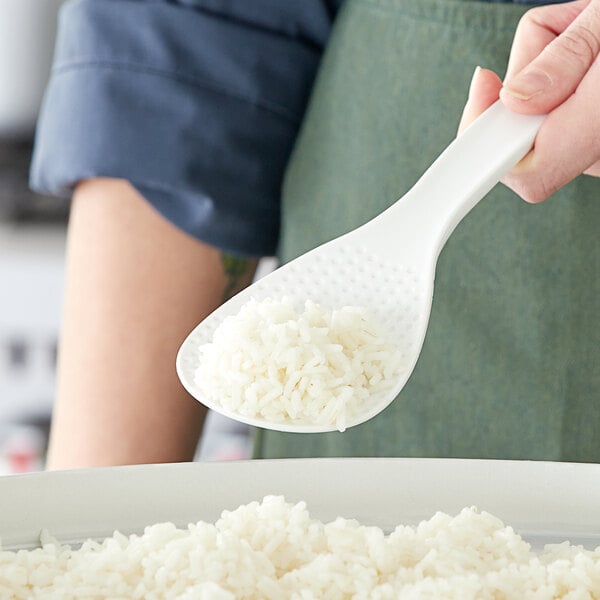
Rice Spoon
A rice spoon is easily identified by its distinctive, flat bowl. This Japanese serving spoon is used to mix seasoning into rice and serve it without crushing the rice grains and altering the texture of the rice. The paddle also doesn’t cut the rice grains, allowing you to serve a beautifully presented mound of rice.
Uses: Mixing and serving rice
Size: 5 to 12 inches
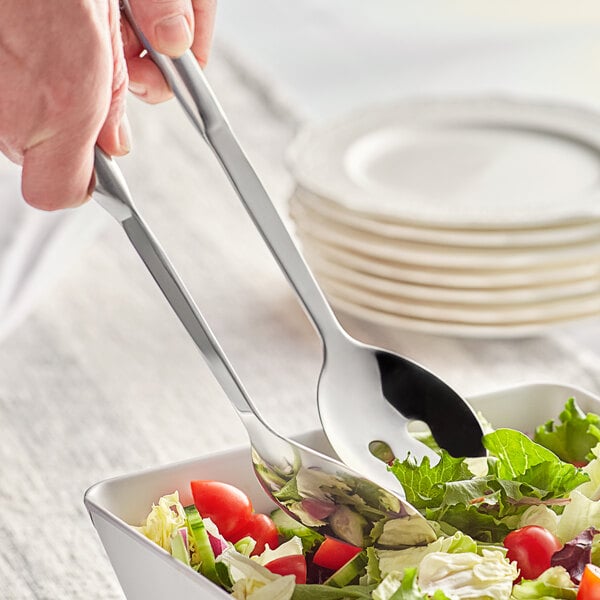
Salad Spoon
Often paired with a salad fork, a salad spoon is used to serve salad in formal dining settings. Made from wood, plastic, and stainless steel, salad spoons have big, shallow bowls that make scooping and serving salad without crushing the lettuce or tomatoes easy. Some salad spoons have decorative handles and designs for fine dining experiences.
Uses: Serving salad
Size: 6 to 15 inches
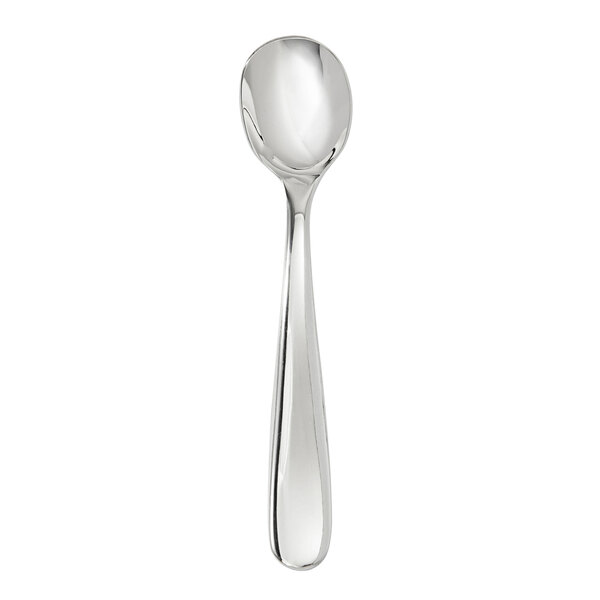
Salt Spoon
Recognizable by its size, a salt spoon is a small, specialized spoon designed for serving coarse or flaked salt in a formal dining setting. The extended, oval-shaped bowl allows you to sprinkle salt on food without spilling it. Additionally, the short handle reduces the risk of losing control of the utensil as your season your dish.
Uses: Serving salt
Size: 2 to 3 inches

Portion Spoon
Perhaps the most common serving spoon in restaurants, a portion spoon scoops a specific quantity of food onto diners’ plates. Portion spoon bowls can be either solid or perforated based on the type of food they’re designed to serve. These attributes contribute to establishing consistent portion control within your establishment, reducing inventory uncertainty and supply budget issues.
Uses: Serving specific portions of food
Size: Varies depending on choice
Whether you own a fine dining establishment or a food truck, eating spoons are a type of flatware necessary for customers to enjoy your food and provide a vital first impression of your restaurant. From the humble dinner spoon to the more exotic caviar spoon, each has unique characteristics and benefits that enhance the dining experience. Below are several common types of spoons used for eating with details on their proper placement, usage, and size.
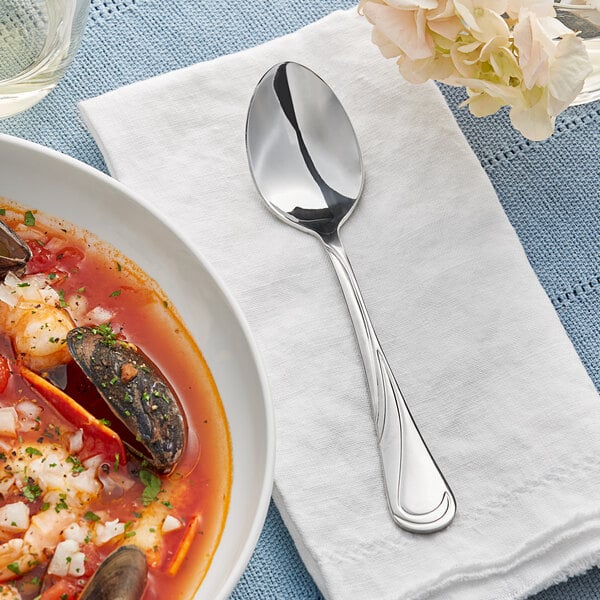
Dinner Spoon
The most common of all eating spoons, a dinner spoon is a staple utensil for all tables in various establishments. With either a round or oval bowl, the spoon’s shape is designed to fit perfectly in your mouth. Dinner spoons should be used during the main course in formal settings, and servers always pair them with four-tine forks on the right side of the knife according to fine dining etiquette.
Uses: All-purpose eating spoon, main course
Size: 6 to 7 inches, roughly the volume of a tablespoon
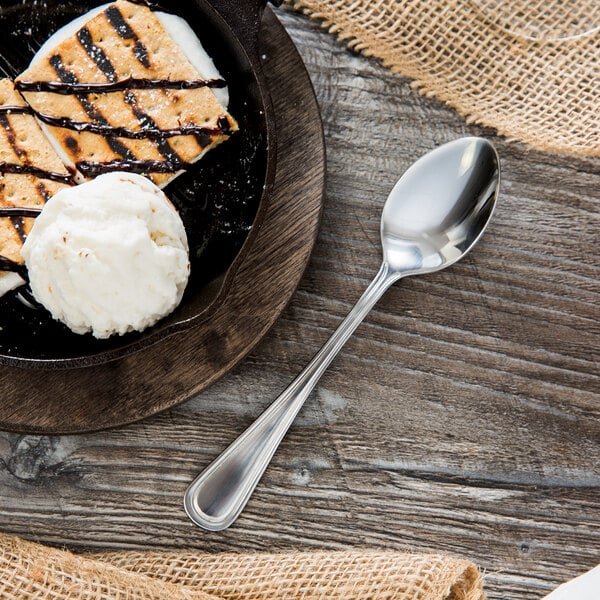
Dessert Spoon
Smaller than a dinner spoon, a dessert spoon is designed for eating desserts. The pointed, oval bowl is longer than a typical eating spoon bowl, making it ideal for perfect portions of sweet treats. While they also belong in informal settings, formal dining etiquette dictates that the dessert spoon be placed above the plate alone or brought in with dessert.
Uses: Primarily eating desserts, but can be all-purpose as well
Size: Varies, somewhere between a teaspoon and a tablespoon
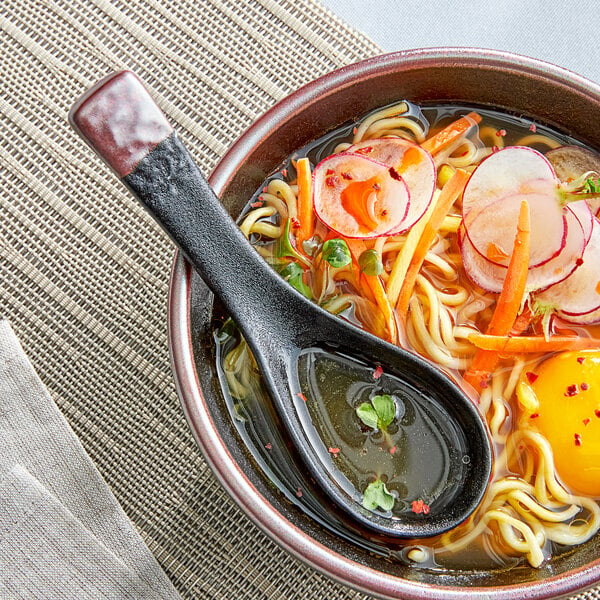
Soup Spoons
Also known as a cream soup spoon, a soup spoon has a deep, round bowl perfect for scooping and sipping on broth and stew. Soup spoons vary between 6 to 8 inches in length with a bowl volume of less than a tablespoon. While most soup spoons follow the traditional British style, other types of soup spoons are also commonly seen in restaurants.
- Bouillon spoon: A bouillon spoon has a short handle and a round bowl rather than an oval bowl, making it ideal for sipping clear, broth-based soups. Do not use a bouillon spoon if your soup is heavy or thick.
- Chinese soup spoon: A Chinese soup spoon is round and shallow with rounded edges, almost resembling a tiny bowl. They are ideal for slurping rice and noodles from a bowl of soup.
- Japanese ramen spoon: Similar to Chinese soup spoons, Japanese ramen spoons have a deep bowl shape and have shorter handles than their counterparts. They are typically made of plastic or wood and have colorful, decorative designs.
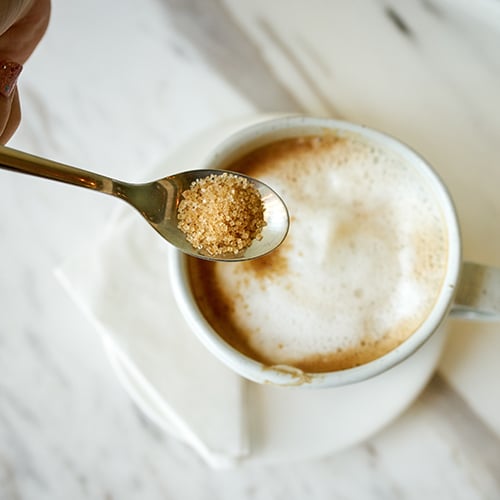
Coffee Spoon
Though coffee is a beloved beverage worldwide, a coffee spoon is a rare find and typically belongs as part of a special set of dishes. Some establishments have coffee spoons to serve alongside after-dinner cups of coffee. However, coffee spoons are not used alongside breakfast coffee or in ordinary coffee shops.
Uses: Stirring sugar and cream into coffee, sipping coffee
Size: Roughly the size of a teaspoon
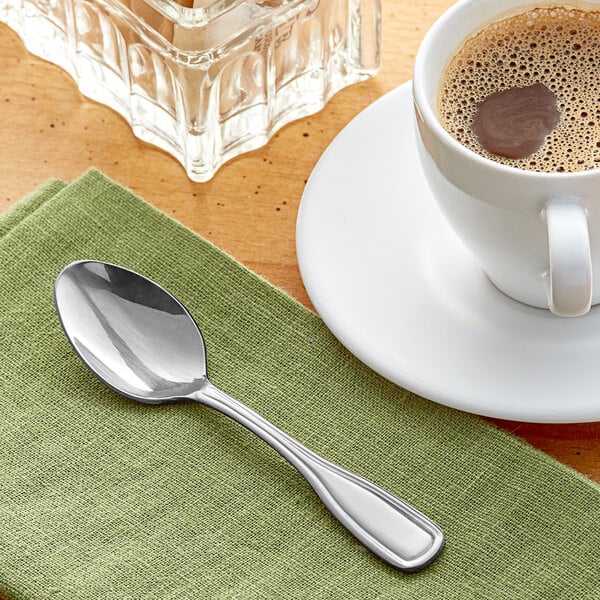
Demitasse Spoon
Smaller than a coffee spoon, a demitasse spoon is designed to fit with an espresso cup. Commonly found in Europe and high-end establishments in the US, demitasse spoons are made from gold, silver, or stainless steel and often have ornate designs. In addition to stirring their beverage, people also use these spoons to scoop foam off the top of their drink and taste it.
Uses: Stirring sugar and cream into an espresso or tea, sampling froth from a cappuccino
Size: 3 to 4 inches in length, less than a teaspoon in volume
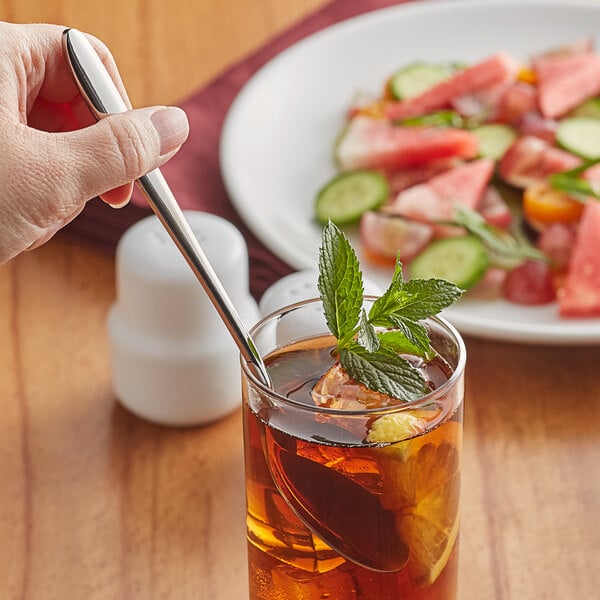
Iced Tea Spoons
Identified by their distinctive long handles, iced tea spoons are perfect companions to tall glasses of iced tea on a summer day. The small bowl and long handle are ideal for stirring sodas, alcoholic drinks, and iced tea, but they can also be used for eating large sundaes or milkshakes. While iced tea spoons are not part of a typical table setting, many establishments serve them alongside specific beverages to allow customers to stir their drinks to keep ingredients from settling as they enjoy them.
Uses: Stirring iced tea, cocktails, sodas, or milkshakes
Size: 7 to 10 inches in length, volume of one teaspoon
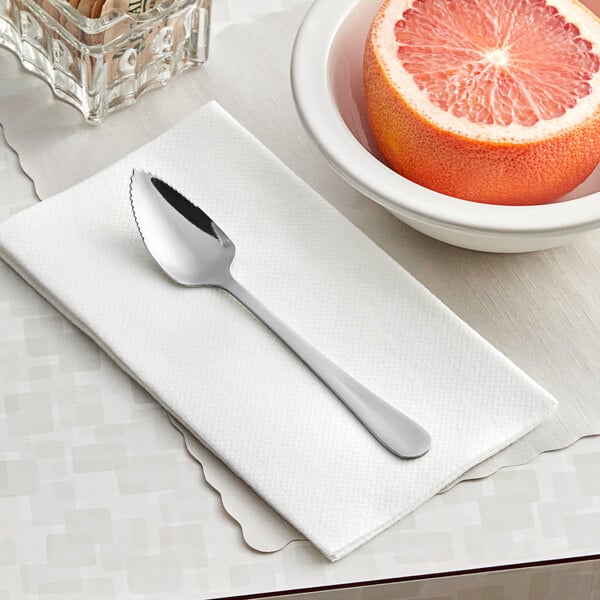
Grapefruit Spoon
Also known as an orange spoon, a grapefruit spoon has serrated edges and a pointed bowl used to separate the fruit from its rind. This multifunctional utensil eliminates the need for a knife and a spoon by combining them into one item. Since these spoons cut and eat citrus fruits, they are made from stainless steel.
Uses: Separating fruit from rinds, eating citrus fruits
Size: 5 to 8 inches in length, volume of roughly one teaspoon
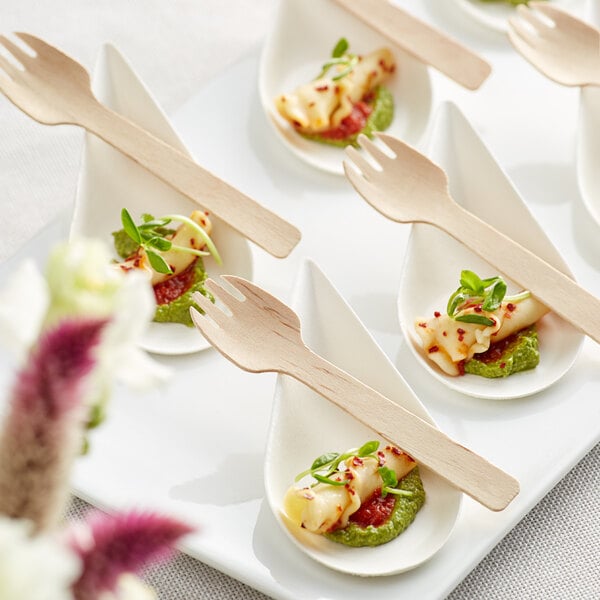
Spork
A spork combines a spoon and a fork, making it a versatile utensil. Typically, sporks have a spoon-shaped bowl at the base that morphs into a set of four or five prongs at the tip. As a result, they can be used to spear and scoop items. While uncommon in most dining settings, sporks are extremely handy for rustic outdoor dining experiences.
Uses: Eating different types of food without changing utensils, great for outdoor settings
Size: 5 to 7 inches
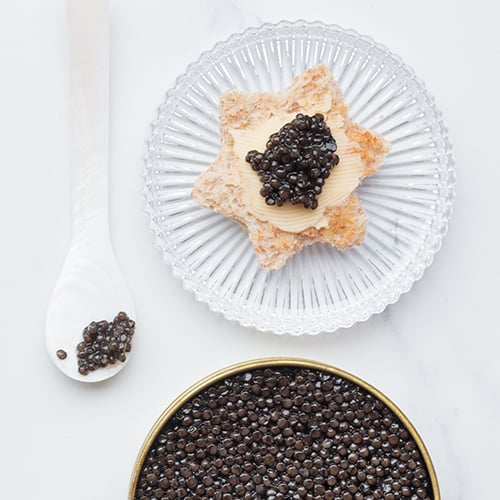
Caviar Spoon
While most spoons have distinctive shapes or purposes, a caviar spoon is differentiated by its material. Most caviar spoons are made from mother-of-pearl, gold, silver, wood, or an animal horn to protect the caviar’s flavor and texture. They are also smaller than most spoons given their shallow bowl and long handle, which prevents people from touching the caviar.
Uses: Eating caviar
Size: 2 to 5 inches
Measuring spoons are a staple of any kitchen regardless of the kind of restaurant or bakery. Having the correct types of measuring spoons allows you to add the perfect ingredient quantities without a thought. Unlike other types of spoons, measuring spoons are differentiated by volume, not shape or usage. Typically, measuring spoons come in sets of various sizes and volumes, allowing chefs and bakers to measure ingredients accurately. Below are a few of the most common measuring spoons you need in your kitchen.
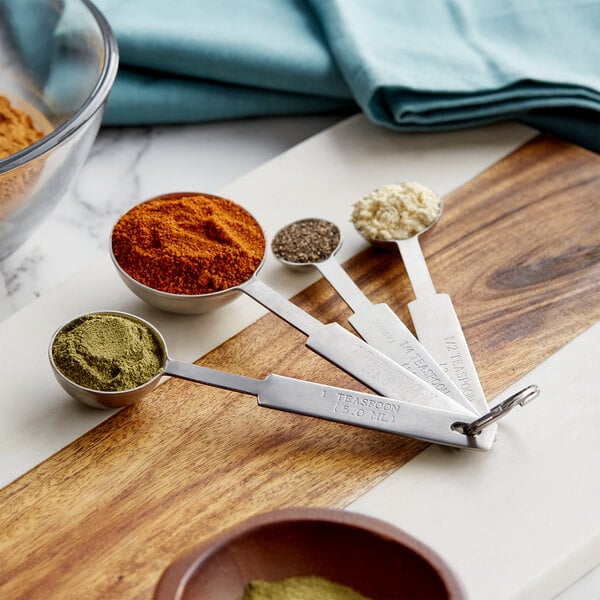
- Teaspoon: A teaspoon has a volume of 4.9 mL and comes in the shape of either a spherical measuring scoop or a child-sized dinner spoon.
- Tablespoon: A tablespoon has a volume of 14.8 mL and comes in the shape of either a spherical measuring scoop or a large dinner spoon. As a result, tablespoons can also be eating utensils.
- Coffee measuring spoon: Perfect for baristas and coffee lovers, a coffee measuring spoon has a round, deep bowl designed to measure coffee grounds to brew consistently flawless coffee.
- Measuring scoop: Used to measure ingredients in larger volumes, measuring scoops are sized to measure in cups or ounces. Some have small holes in the bottom to allow the excess liquid to drain.
Special occasions and tasks require something different than a standard cooking, eating, or serving spoon. Due to their unique shapes, sizes, and materials, specialty spoons can serve particular purposes in the kitchen and throughout the dining experience. Below are several types of specialty spoons you might use throughout your establishment.
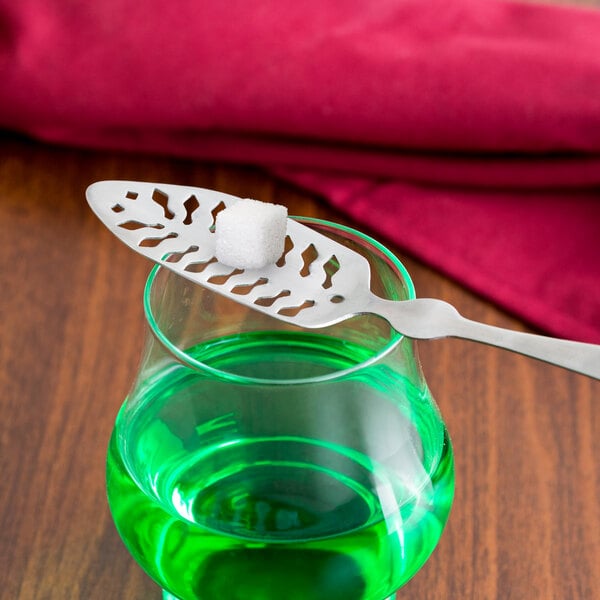
- Absinthe spoon: If your establishment serves absinthe, an absinthe spoon is specifically designed for preparing the beverage. They have a long handle, a notch to rest the spoon in the glass, and a flat, slotted bowl with ornate designs.
- Tasting spoons: Perfect for establishments serving appetizers, a tasting spoon is a small, narrow spoon with a squared-off bowl designed for sampling dishes.
- Egg spoon: Designed for eating boiled eggs, an egg spoon has a small, flat bottom with a curved handle and a pointed bowl.
- Olive spoon: With a long handle and wide, shallow bowl, an olive spoon makes it easier to remove olive pits from olives using its serrated edge and unique design.
- Jam spoon: A jam spoon is a long-handled spoon with a shallow, pointed bowl used to serve jam, jelly, and other fruit preserves and spread it onto bread.
- Plating spoons: For high-end restaurants that take meal presentation to the next level, plating spoons allow chefs to carefully scoop and drizzle food items and create an aesthetic entree.
- Mustard spoon: Similar to a salt spoon, a mustard spoon is a small spoon with a long, thin handle and a scalloped bowl used to scoop out mustard.
- French sauce spoon: Also known as a saucier spoon, a French sauce spoon is the same size and shape as a dessert spoon with a flattened bowl used for scooping up sauce. It is used during the meal's meat or fish course to eat the extra sauce accompanying the dish.
Related Resources

May 2024 WebstaurantStore Coupon Code
Spring is in full bloom, and to celebrate Webstaurantstore is offering a variety of amazing monthly deals! In May, you'll discover incredible prices on beverageware, dessert ingredients, and food packaging supplies. Take a look at our selection of sale items below and don't forget to enter the code MAYFLOWERS at checkout to enjoy savings of up to 30%! We're also excited to introduce the new Webstaurant Rewards® Visa Business Card ! Sign up for a new card today and start earning rewards on every WebstaurantStore purchase. Use Coupon Code: MAYFLOWERS Finest Call Premium Tropical Puree Mix 1 Liter reg. $4.19 Each $3.77 Shop Now Blue Henry Dried Blood Orange Slices - 20+ Slices per Box reg. $12.49 Each $8.74 Shop Now Fee Brothers 5 fl. oz. Oran

Types of Knives
Knives are the most important tool in a chef's kit, and they can be used for just about any food prep task from chopping onions and butchering a cut of beef to opening oysters and slicing bread. But, there are different types of kitchen knives that are designed for various purposes. This comprehensive guide covers the types of knives and their uses, so you can find the right option for your needs. Shop All Kitchen Knives Use the following links to navigate and learn about the different types of knives: Kitchen Knife Types Types of Table Knives Parts of a Knife Carbon Steel vs Stainless Steel Knives Forged vs Stamped Knives Types of Knife Edges Knife Handle Styles Knife Maintenance Kitchen Knife Storage

Types of Plates
When it comes to choosing plates for your commercial establishment, it's important to consider the different types available. The right type of plate can enhance the presentation of your food and contribute to a positive dining experience for your customers. Whether you're choosing plates for your restaurant or next catered event, use this guide to determine which type of plate and plate size you need based on what you're serving. Shop All China Plates Use the following links to jump to the different plates that interest you most: Dinner Plates Dessert Plates Appetizer Plates Salad Plates Charger Plates Luncheon Plates Bread and Butter Plates How to Choose the Best Plate
- Topics 1364
- Industrial 55
- Troubleshooting Guides 21
- Restaurant Management 129
- Bar Management 57
- Catering Tips 37
- Bakery Management 42
- Food Trucks & Concessions 49
- Advertising & Marketing 37
- Eco-Friendly Tips 11
- Facility Layout & Design 42
- Coffee Shop Tips 29
- Installation & Maintenance 52
- Janitorial & Pest Control 30
- Safety & Sanitation 88
- Startup Tips 104
- Menu Design 10
- Kitchen & Cooking Tips 84
- Hospitality Management 24
- Pizza & Sandwich Shop Tips 36
- Smallwares 37
- Food Prep 90
- Tabletop Items 17
- Disposables 22
- Calculators & Tools 6
- Consumables 52
- Warewashing & Laundry 19
- Cooking Equipment 92
- Food Storage & Refrigeration 51
- Beverage Equipment 35
- Office Supplies 6


